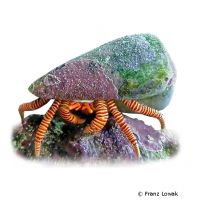Halloween Hermit Crab (Ciliopagurus strigatus)
| Halloween Hermit Crab Ciliopagurus strigatus | |
|---|---|
| Name | Halloween Hermit Crab |
| Name Lat. | Ciliopagurus strigatus |
| Family | Hermit Crabs |
| Family lat. | Diogenidae |
| Order | Decapoda |
| Order lat. | Decapoda |
| Origin | Indo-Pacific, Red Sea |
| Diet | Omnivore |
| pH | 8.1-8.4 |
| Hardness | 8-12 °KH |
| Lighting | Low |
| Current | Moderate |
| Behavior | Peaceful |
| Keeping | Individual, group |
| Care Level | Easy |
| Life Span | N/A |
| Protection | No |
| Metric Units | |
| Size | 5-6 cm |
| Temperature | 22-27 °C |
| Salinity | 33-36 ‰ |
| Aquarium | 100 l |
| US Units | |
| Size | 2"-2.4" |
| Temperature | 72-81 °F |
| Salinity | 1.020-1.025 sg |
| Aquarium | 25 gal |
Distribution and habitat
The distribution area of Ciliopagurus strigatus is the Red Sea and the Indo-Pacific, where they occur from East Africa through Indonesia and Australia to Hawaii. They live mostly under coral blocks in deeper reef sections but also on the reef top.
Maintenance
They need a well-structured aquarium with a reef structure (crevices, caves, shelters) and sandy areas, with live stones that they can graze on (algae) and that act like a biological filter. There must always be several empty snail shells of different sizes available for each animal.
Only substrates rich in lime and free of heavy metals may be used as substrate. Filters, skimmers and heaters are necessary to ensure water quality, as well as pumps to simulate tides, swells and bottom currents. Lighting must match the species-appropriate day-night rhythm of the animals
| Salinity: 33-36 ‰ | pH value: 7.9-8.5 |
| Carbonate hardness: 6-10 °KH | Nitrate content: 2-8 mg/l |
| phosphate content: 0.01-0.1 mg/l | nitrite content: 0.0-0.05 mg/l |
Regular addition of trace elements, especially calcium, iodine and magnesium is recommended. For salinity, an average value should be aimed for, which may only vary slightly by +/- 0.5 ‰. Ammonia and ammonium must not be measurable. Special attention shall be paid to consistently good water quality and water values.
Diet
In nature they feed mainly on algae growth and detritus. Special feeding is usually not necessary in a community tank, as they partake of the fish food (small mysis, krill, artemia, bosmids, dry food, etc.). If there is too little algae in the aquarium, dried nori algae leaves must be offered 1-2 times a week, supplemented with a frozen food mixture with a high vegetable content
Regular and varied feeding promotes health and increases resistance.
Behaviour and compatibility
They can be kept well in a group. Keeping several animals is only recommended in a larger, well-structured aquarium with sufficient food supply. Socialization with fish and invertebrates by which they are not considered food is very possible. Occasionally predatory towards small fish and snails.
Reproduction and breeding
No external sex differences are known. The female carries the egg packets in the snail shell under the pleon. The movement of the pleopods (webbed feet) fans the egg packets with fresh water. The free swimming larvae live planktonic and go through several stages of development. After the last larval molt, they must move into a snail shell of suitable size for further development
There are no known reports of successful breeding in the aquarium.
Important
They scrape algae and food remains from the substrate, are good for algae control and also eat cyanobacteria. As detritus recyclers, they burrow in the substrate, providing its aeration and waste recycling.
Hermit crabs protect their abdomens in snail shells that they carry around. After each growth moult, a larger snail shell must be sought. This can lead to intraspecific aggression among the crayfish. Empty Conus or Strombus shells must always be available in the aquarium, because the crayfish are always looking for a "better" shell. If different species are kept together, care must be taken to ensure that fish and invertebrates match each other in terms of water quality and temperature requirements and social behavior, and that the setup meets the ecological needs of all species kept together. Newly introduced animals must be acclimated slowly to the water in the aquarium. Further literature can be found in your pet store.
References
Text: Werner Winter; Image: Franz Lowak
Source: FOSSÁ & NILSEN (1995): Korallenriff-Aquarium Bd. 6, Birgit Schmettkamp Verlag; ENGELMANN & LANGE (2011): Zootierhaltung - Tiere in menschlicher Obhut: Wirbellose, Verlag Harri Deutsch
